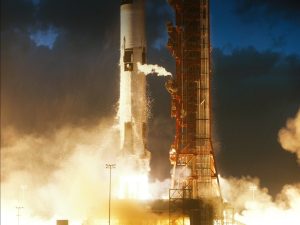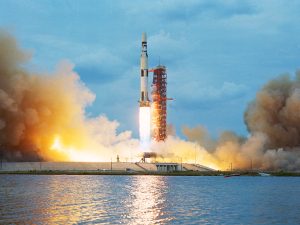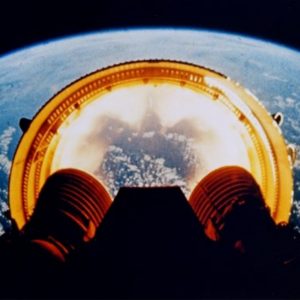
Behind each rocket launch, there’s a basic scientific principle to explain what’s happening.
Chances are, you’ve heard of Newton’s three laws of motion. Today, we are taking a closer look at Newton’s second law and how it can be applied to human spaceflight.
What is Newton’s Second Law?
Newton’s second law can be summed up in a simple mathematical equation where Force (F) is equivalent to the mass of an object (m) multiplied by its acceleration (a), or F=ma.
To put things simply, an object’s acceleration is dependent upon the amount of force that is applied to it, and its mass.
However, it might help to first define these terms.
A force is simply a push or pull acting upon an object. Acceleration can be defined as an object’s change in velocity over time, considering both speed and direction. Lastly, the mass of an object is the amount of matter that an object contains, and unlike weight, this quantity will not change with location.
Watch the STEMonstration clip below to watch NASA astronaut Randy Bresnik demonstrate Newton’s second law of motion onboard the International Space Station (ISS):
But what if an object’s mass isn’t constant? Well, that’s where things get interesting.
The above equation, F=ma, assumes a constant mass.
For objects that do not have a constant mass, the differential form of the equation is used, where the force is equivalent to an object’s change in momentum over time, or F=(m1V1-m0V0)/(t1-t0).
How can this law be applied to rockets?
Have you ever watched a rocket launch and wondered how such a massive object can lift off the Earth and into space? Would you have guessed that Newton’s second law of motion can help explain exactly what we see during launch?
It might not be the first thing you think about while watching a rocket blast off, but these spectacular events make for a great teachable moment in physics.
A rocket’s mass is comprised of many different components – engines, payload, propellants, and more. However, the largest part of a rocket’s mass goes to the solid and/or liquid propellant.
Simply put, a rocket is essentially a large chamber that holds gas under pressure with a small opening to vent the gas at liftoff. During launch, a controlled explosion occurs, and gas is vented from the opening in the chamber, generating thrust and propelling the rocket in the opposite direction of the escaping gas- up to space.

But as a rocket lifts off, something happens to its mass. It changes. Why?
The engines burn the propellant to fuel the rocket, using it all up until it is gone. Thus, the rocket’s mass becomes smaller as the rocket ascends.
So, in keeping with Newton’s second law of motion, the rocket’s acceleration increases as its mass decreases. This is why a rocket lifts off slowly at first, then speeds up.
In short, rocket scientists must consider all of a rocket’s components (which make up its mass) to calculate the amount of force required to accelerate the rocket into space (must reach escape velocity, a speed of over 25,014 mph).
Newton’s second law gives them a way to do this.
As NASA covers in their Rocket Principles lesson, the higher a rocket’s propellant mass, the faster the gas in the rocket’s chamber can escape, generating a greater amount of thrust at launch.
It’s thanks to Newton’s principles like his second law of motion that rocketeers were able to develop mighty space-age rockets like the Saturn V, which weighed 6.2 million pounds fully fueled on the launchpad and could generate 7.6 million pounds of thrust at liftoff.
Learn more about Newton’s second law in the context of space by clicking here, and be sure to check out NASA’s Newton in Space lesson for educators of grades 5-8 here.









